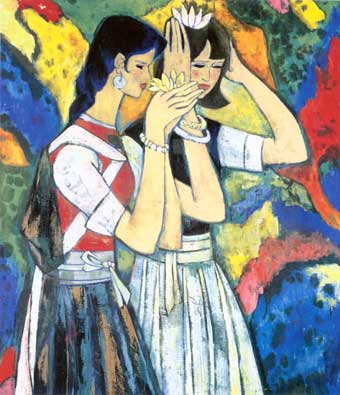
He was increasingly inspired by the form and meaning of the pictographs of Naxi Dongba, or shamanistic priests. He used typical pictographs, such as the sun, birds and water, as themes.
In 2000, on invitation of his alma mater, he returned to Beijing to teach and continued his research on Naxi ancient pictographs.
In his book, An Annotation of Ancient Naxi Pictographs, published by the Ethnic Publishing House last year, Naruo describes his 20 years of research as "lonely and happy", and his current life as "quiet and happy".
The book, a collection of more than 800 pictograph words and almost 100 sentences, introduces the skills of "writing" and painting, and shows his oil paintings with the typical elements picked from the Naxi ancient texts.
Almost 1,000 sentences he collected are not included. He plans to publish more books when he has enough money, but he won't sell them.
"I give them to my friends who really like Naxi culture. I think it's a better way to spread Naxi culture," he says.
His simply-decorated and barely-furnished apartment near the campus is full of painting materials.
Almost 20 pairs of shoes are lined up in the corridor next to the door.
"It's convenient for me to put them on when I go for a walk," he laughs.
Passing the "shoe corridor", one can see a big working desk with painting tools and half-finished works.
On the left is a small bedroom and on the right a bigger one to store his collections and finished paintings.
There is an open kitchen at the end of the living room with a refrigerator always full of raw food.
"An artist should first make his stomach full, and then he can focus on his creation," Naruo says with a smile.
He recalls visiting the artists' town in Songzhuang, on Beijing's eastern outskirts, which has become one of the centers of the city's burgeoning art scene over the last 10 years, drawing artists with its cheap rents and proximity to the capital's growing markets and galleries.
But he disliked the atmosphere. "An artist needs quietness and loneliness. I prefer staying here," he says.
Everyday he rises early, spending half the day painting and the other half walking the campus, visiting friends or reading.
Although Naruo looks down on commercial artists, money was once the biggest obstacle to realizing his cultural preservation dream.
In 2000, the year he returned to China, he spent 50,000 yuan (7,400 U.S. dollars) on a half hectare of land together with houses in his hometown to build a cultural center, where leading foreign and Chinese artists could live, communicating with local artists and residents.
"They can get inspiration from the local ethnic lifestyle and have a better understanding of the Naxi culture, while local artists and children who are interested in arts can learn from them," he says.
He refurbished the houses as artists' accommodation and studios. However, he had to abandon the project due to a lack of follow-up investment three months after its establishment. He sold it to local businessmen and now it is a teahouse.
He looks to Xuan Ke, another Naxi elder, who has devoted himself to the preservation and spread of Naxi traditional music, as a model.
"He made a perfect combination of arts and business. His band is learning and teaching traditional skills while performing commercially."
Sometimes, after finishing painting, he sits at a small desk on the balcony of the 17th floor, looking out at the city, to write down his life with a China-made ink pen and a notebook.
He disdains computers, especially the Internet.
"There is too much useless information on the Internet, which will distract me from focusing on creation."
He avoids the artist salons that have become popular as the the art market has developed.
"The persistent topic of such salons is women, not arts," he says.
He seldom returns to Lijiang as he says it has been commercialized.
"The culture is in my mind. There is no need for me to go somewhere to look for it."
He remembers fondly the life in the United States, completing the Washington Marathon, restoring murals for the Washington Project for the Arts, playing baseball and friends from many nationalities and walks of life.
From time to time, universities invite him to give lectures on Naxi painting, murals and culture, always arranging interpreters for him.
"Why do they still invite me although I don't speak English?" he asks.
"Because I have things that they don't."
(Xinhua News Agency May 29, 2009)